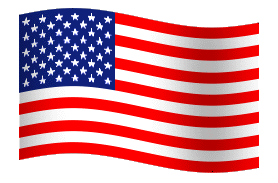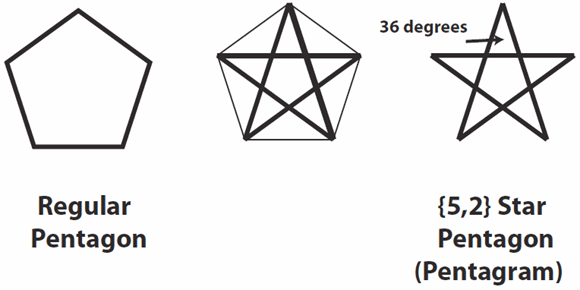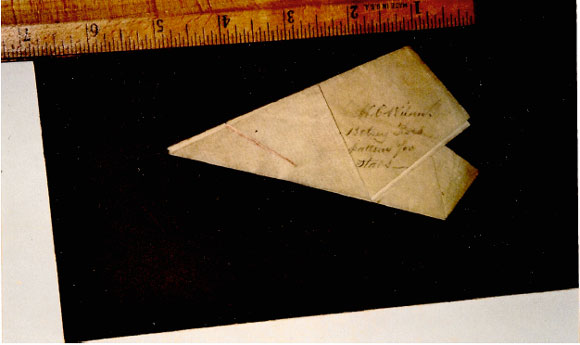
Betsy Ross and the American Flag
Two Conundrums Concerning the Betsy Ross Five-Pointed Star: the Provenance of the Pattern-for-Stars Artifact and the Surprising Incompleteness of Fold and One-Cut Descriptions for Making the Star
Arnold Tubis, Department of Physics (Ret.), Purdue University, West Lafayette, IN Visiting Fellow, University of California San Diego, La Jolla, CA
Crystal E. Mills, California Mathematics Council ComMuniCator, Clayton, CA
Presented in ushistory.org by kind permission of the authors
Introduction
The five-pointed star, which appears on many flags and standards, almost universally has the shape of a pentagram (Figure 1), whose construction is closely tied to that of a regular pentagon.(1) It is sometimes referred to as a “perfect” five-pointed star and (especially in the USA) a “Betsy Ross” star. This latter name is linked to the historically controversial Betsy Ross flag story that involves Ross’s alleged making (by a fold and one-cut method) a five-pointed star before a visiting committee headed by George Washington in May or June of 1776. Since the 1980s, the story has been a subject of renewed scholarly interest. See, e.g., Timmons and Yarrington (1983), Morris (1982), Harker (2005), and especially Miller (2010), the first comprehensive historical examination of the life and times of Betsy Ross. In the world of origami, the Betsy Ross flag story has been prominently referenced as an early pre-curser of modern fold and one-cut algorithms (Demaine and Demaine, 2004; Demaine and O’Rourke, 2007). (2)
In this paper, we address two puzzling aspects of the fold and one-cut Betsy Ross star: 1) the properties and provenance of the Pattern for Stars Artifact, a material item that has been claimed to support the flag story; and 2) the surprising incompleteness, which can be easily remedied using elementary geometry, of almost all presentations in books, articles and on the Internet of fold and one-cut procedures (2) for making the star.
Reeves Wetherill and the Pattern for Stars Artifact
The Pattern for Stars Artifact (Figure 2) is a folded 5"x 8" piece of paper with a partial scissor cut (that gives an approximate pentagram shape) and the lead pencil inscription: H. C. Wilson, Betsey Ross, pattern for stars. First-hand information about it has so far been found in just two short articles in the Philadelphia Inquirer, records of the Atwater Kent Museum of Philadelphia, and the book of Morris (1982).
The Inquirer articles are contained in the scrapbooks of Reeves Wetherill of Philadelphia, which are now archived in the Atwater Kent Museum. The first article (from either 1962 or 63) announces that the star pattern, described as being “yellowed with age” would be on exhibit at Wanamaker’s (in the Rug Department). The second one from June, 1963 is by Ruth Seltzer, who wrote a column called The Philadelphia Scene. Her article reads as follows:
AN EXCITING DISCOVERY regarding flag-maker Betsy Ross was revealed day before yesterday at a festive Flag Week Luncheon in the Burgundy Room of the Bellevue-Strafford. The timing was interesting. It was the 20th annual luncheon staged by the Woman’s Committee of the Philadelphia Flag Day Association.
Presiding at the anniversary celebration was Mrs. Gustav Ketterer, who ran the first lunch in 1943 and has been chairman ever since. Mrs. Ketterer introduced the speakers — Mrs. Joseph Carson and Reeves Weatherill.
In her speech, Mrs. Carson revealed that a paper pattern made by Betsy Ross exists here in Philadelphia — Betsy’s pattern for her five-point star. The folded star can be cut with a single snip of the scissors.
The pattern was brought to the luncheon by Mr. Wetherill. It was found back in 1922 by his father, the late Abel P. Wetherill, who employed a safecracker to open a safe. The safe, which had belonged to ancestor Samuel Wetherill, hadn’t been opened in over a century.
There was a pistol in the safe, with a bullet still in it. There was a deed signed by John Penn. But the most fascinating discovery was the star pattern. This old piece of folded paper is alleged to have been given to Samuel Wetherill by Clarissa Claypoole Wilson. Clarissa was Betsy’s daughter by her third husband, John Claypoole.
Samuel Wetherill was a founder of the Society of Free or Fighting Quakers. He was a life-long friend of Betsy.
“Betsy’s star pattern is the missing link as far as I’m concerned,” Reeves Wetherill told us. “Why would so small a piece of paper be stored in a safe unless it had real significance?”
Declared Mr. Wetherill: “I plan to give the pattern to the Betsy Ross House.”
Who said Betsy didn’t make the first flag? A little piece of paper seems to prove she did!
Timmons and Yarrington (1983) reference the Seltzer article as their source of information about the artifact. Harker (2005) references Timmons and Yarrington. However he states that, according to the present-day Clerk of the Society of Free Quakers, the safe did not belong to Samuel Wetherill, but to a Wetherill of a later generation. Morris (1982) does not reference the Seltzer article but on page 116, Reeves Wetherill is quoted as saying that: “The safe, unopened, remained in my family for many years. One day, about 1925, my father invited me to go to town on Sunday because he had hired a safe blower to open the original Samuel Wetherill safe .... It was blown open and in it we found the star with notations ....“ Reeves is also quoted as saying that: “long ago he loaned the star to the Atwater Kent Museum and while there it was examined scientifically for verification and it .... checked out perfectly by chemical analysis as to its age.” In a personal communications to us, Jeffery R. Ray, Senior Curator, Philadelphia History Museum at the Atwater Kent, said that the paper artifact was indeed loaned to the Atwater Kent Museum in 1940, and that the Museum had a working relationship with the Franklin Institute, where an analysis might have occurred. Ray is currently searching the Atwater Kent and Franklin Institute records to see if tests were actually carried out. (3)

Figure 1. The pentagram in relation to the regular pentagon.

Reeves Wetherill, who died in 1992, was a rather colorful person. As vice-president for public relations at the John Wanamaker Department Store, he hosted, interviewed and entertained many famous visitors to Philadelphia and was commonly referred to as Philadelphia’s official greeter. He was a descendant of Christopher Wetherill, who settled in Burlington County, NJ in 1683. Among his ancestors was Samuel Wetherill, the founder (in 1781) of the Free Quakers, who broke away from the Religious Society of Friends to support the American fight for independence. Reeves served as clerk of the Society of Free Quakers for 30 years, and worked for the preservation of the Free Quakers Meeting House at Fifth and Arch Street. He also collected manuscripts, books, and pamphlets about the society, and donated them to the Pennsylvania Philosophical Society.
Because Betsy Ross and her third husband, John Claypoole, joined the Free Quakers in 1785, and she was a friend of Samuel Wetherill, the artifact has been used to support the above-mentioned flag story. Reeves Wetherill donated it to the Free Quakers, and for many years, it was on display at the Society of Free Quakers Meeting House. It was photographed many times [see, e.g., Timmons and Yarrington (1983) and Harker (2005].(4) It was unfortunately stolen from its unlocked display case in 2004. The photos do not indicate that folding techniques were used to determine the precise location of the scissor cut.
Folding and One-Cutting a Pentagram Shape from an Unmarked Rectangle
It is a fairly straightforward problem in geometry to fold and one-cut from an unmarked rectangle, not only a near perfect pentagram shape but also the shapes of any arbitrary regular polygon and its associated star polygon(s) (e.g., Tubis and Mills, 2005, 2009, 2010). The procedure in the case of a pentagram shape involves first dividing (exactly or approximately) a straight angle into five equal angles of measure 36° and then determining the placement of the scissor cut via folds (5) that define an isosceles triangle with internal angles of measures 18°, 144°, and 18°. We illustrate in Figures 3a and 3b the folding/one-cutting procedure involved in the case of 8- inch x 10 inch paper (the paper size favored in most of the Internet presentations). Note the 18° — 144° — 18° isosceles triangle defined by crease lines and the cut line in Step 10. The procedure in Tubis and Mills (2010) can be used to fold and one-cut a pentagram shape from any rectangular piece of paper. Figure 4 shows one of the many possible fold/one-cut procedures for making the pentagram shape from a starting square (the widely used starting paper shape in contemporary origami). The steps in Figure 4 can also be easily modified so as to apply to the case of any arbitrary starting paper rectangle.
Incompleteness of Instructions for Folding and One-Cutting the Betsy Ross Star
In view of the simple geometry involved, it is surprising that all of the many Internet websites and YouTube videos we have surveyed that purport to show: ”how to fold and one-cut a Betsy Ross five pointed star” fail to indicate how to exactly determine, by folding alone, the final scissor cut. For a typical example, see: enchantedlearning.com/crafts/Star.shtml. With no folding landmarks given, the cut in step 5 is only vaguely specified. It is therefore highly likely that following the current instructions will lead to a star whose points are “too fat or too thin”.
With the exception of Tubis and Mills (2005, 2009, 2010), the lack of crease landmarks for the cut is also characteristic of all the fold and one-cut instructions for five-pointed stars we have found so far in books and articles written over the past century and a half. See, e.g., Ball (1892), Maltby (1894), Popular Science Monthly (1916), Houdini (1922), Leeming (1939), Loe ( 1955), Thompson (1972), Temko (1974), and Franco (1999). The book of Maltby is significant, because it contains a substantive amount of origami geometry and heavily reflects the influence in America of the paper folding/cutting approach to early mathematics education promoted worldwide by Friedrich Froebel (1782–1852) and his followers. Apparently, the book was used extensively in the training of teachers in Pennsylvania. The fold and one-cut star described in it is clearly meant to be one appearing in the American flag. The cut line however is simply indicated without an explanation of how it was determined. The stars in the Ball, Houdini, Leeming, and Temko books are not claimed to have the shape of a pentagram. The one in the book by Loe definitely has the pentagram shape, but a 18° template is used in making it. Thompson (1972), and Timmins and Yarrington (1981) contain a description, taken from the World Book Encyclopedia, of how to fold/one-cut a Betsy Ross star from a square. The resulting star is asymmetric, that is, not all of the star points have the same shape, and all of the points are “too fat.” The lack of folding guidelines for the scissor cut in Franco (1999) is surprising since this book was specifically written in an attempt to integrate origami with mainstream high school mathematics. Biddle and Biddle (1993) present a novel way, which was invented by Shuzo Fujimoto of Japan, to fold, without cutting, a pentagram shape using A4 paper.
An interesting early mathematical study of the fold/one-cut aspects of the Betsy Ross star was that of the Philadelphia author, editor and Historical Society member Charles J. Lukens (Lukens, 1873). George Henry Preble, a noted flag historian, had requested that Lukens do this study. Only two pages of the Lukens drawings are now accessible.(8) On the first page, he drew a pentagram shape with the aid of a compass and straight edge. He then correctly indicated the fact that after the paper is properly folded so that all of the 10 sides of the pentagram shape are on top of each other, the cut line will coincide with one of the sides. He also showed how to start folding the paper so as to arrange the 10 sides of the pentagram shape on top of one another prior to the making the cut. However, his drawings do not make clear, at least to us, how the cut line was to be determined if only an unmarked sheet of paper was used.
Discussion
The Betsy Ross flag story is probably destined to remain historically controversial. We can only hope that some useful information concerning the artifact will be found in the archives of the Atwater Kent Museum and the Franklin Institute, and/or that the artifact will be recovered so that tests can be done on it to assess the credibility of its possible connection with the flag story.
It is important to note that: 1) the cut line of the artifact gives a slight but noticeable deviation from a pentagram shape for the star; and 2) the absent crease landmarks for the cut in the artifact could easily have been made on the basis of simple geometric reasoning that has been known since, and probably well before, the time of Euclid (300 BCE). Therefore, even if the connection of the artifact to Betsy Ross is eventually established, it is doubtful that her making of a fold and one-cut star was based on detailed knowledge of the geometry that she may have learned in school. It is more likely that she had previous experience in making stars from her work in upholstery, in which the correct cut line was determined by a “practiced eye” or perhaps with the aid of an angle template. (9)
It should be noted that the five-pointed stars on many early American flags, and even one allegedly made in 1861 by Betsy Ross’s daughter, Clarissa Claypoole Wilson, have shapes that deviate significantly from that of a pentagram. Therefore it should not be surprising that the artifact gives only an imperfect pentagram shape.(10)
In any case, as emphasized by Miller (2010), the many well-documented aspects of Ross’s life as a wife, mother, businesswoman, flag maker, and patriot firmly establish her as a significant presence in American history, and the flag story, even if never corroborated, will undoubtedly continue to be a notable part of our national folklore.
The Betsy Ross flag story constitutes a unique gift to grade K–12 educators and students. There are obviously many creative and effective ways of using it at various levels of sophistication to design classroom activities that relate to American history and the role of women in it, origami, and, of course, mathematics; algebra, geometry, trigonometry. As we have shown elsewhere (Tubis and Mills, 2005, 2009, 2010), it can naturally lead to rich explorations of fold/one-cut regular polygons and star polygons with arbitrary numbers of sides.
The general lack of folding landmarks for the cut line in almost all “popular” presentations over the years of how to fold/one-cut the Betsy Ross star is yet another sign of the generally shallow public knowledge of geometry. Its absence even in recent origami books designed to supplement geometry education, such as Franco (1999), is even more disturbing. At the very least, the plethora of incomplete instructions for folding/one-cutting the star should be remedied by making more generally known the two simple extra folding steps required to determine the cut line.
See Folding/one-cutting a Betsy Ross star from 8-1/2 inch x 10 inch paper
Acknowledgments
We wish to thank John Balderston Harker, a fifth generation descendant of Betsy Ross for encouraging our investigations of the Pattern for Stars Artifact, and in particular for supplying us with his personal photos of it. We also thank Jeffery R. Ray, Tracey Kry, and Cary Majewicz for help in obtaining archival materials; and Professor Marla Miller and Linda Eaton for their critical comments on an earlier draft of this article. Finally, one of us (AT) thanks Lisa Acker Moulder, Director of the Betsy Ross House in Philadelphia, for a personal tour of the House and for introducing him to the current chief Betsy Ross enactor.
Footnotes
- The five-pointed pentagrams on most flags are mostly in the form of solid (i.e., filled-in) pentagrams. Notable exceptions include the pentagram stars on the national flags of Ethiopia and Morocco, which have pentagram stars.
- Important technical point: A “fold and one-cut procedure” in this paper is defined as one that involves only folding (i.e., no use of markings on the paper, protractor, angle template, etc.) and a single cut determined by previously made crease marks. This definition is more restrictive than the one associated with the modern fold and one-cut procedures [e.g., Demaine and Demaine (2004); Demaine and O’Rourke (2007)]. These procedures show how to fold a piece of paper on which an arbitrary number of general polygon structures are inscribed, so that all of the polygon lines overlay one another (and that consequently a single cut will result in the production of all of the individual inscribed polygons).
- A dating of the artifact may help to evaluate several inconsistent statements made about it. In the 1992 Philadelphia Inquirer obituary of Reeves Wetherill by Inquirer staff writer Andy Wallace, Reeves Wetherill’s cousin Elkins Wetherill is quoted as saying that the artifact was given to Samuel Wetherill by Betsy Ross herself, and that the Betsey Ross inscription on the artifact was verified as the signature of Betsy Ross. That the artifact was given to Samuel Wetherill by Betsy, and not by her daughter Clarissa, is also stated by Morris (1982) and was mentioned in the signage next to the displayed artifact at the Society of Free Quakers Meeting House. However, this information is at odds with the statements of Reeves Wetherill in the Philadelphia Inquirer article of Ruth Seltzer. We will update this article if any new information concerning the artifact is found in the archives of the Atwater Kent Museum or the Franklin Institute.
- A large number of excellent black and white photos of the artifact are in the Katherine Beale and Charles Barclay family genealogical research materials at the Historical Society of Pennsylvania, Philadelphia, PA. One of us (AT) thanks Cary Majewicz, Technical Services Archivist, Historical Society of Pennsylvania, for helping him find the Betsy Ross materials in the Barclay collection.
- The required folds (see steps 4 and 9 of Figure 3, and steps 7 and 8 of Figure 4) involve making creases for the perpendicular bisector of a line and an angle bisector. The geometric theorems involved are those relating to the properties of the perpendicular bisector of a line and isosceles triangles.
- The angle measures indicated in steps 7, 8, and 10 are rounded to the nearest integer. A simple geometric/trigonometric analysis of the folding process in the case of idealized, that is, infinitely thin and flexible paper, shows that the apex angles of three of the five overlapping flaps in steps 9 and 10 are of measure 35.992°, and the apex angles of the other two are of measure 36.012°. For the case of real-world paper, these deviations from 36 degree measures are insignificant.
- The angle measures indicated in steps 6, 8.and 10 are rounded to the nearest integer. An analysis of the folding process for idealized paper shows that three of the five overlapping flaps in step 10 have apex angles of measure 35.782° and the apex angles of the other two are of measure 36.327°. As in the case of the procedure in Figures 3a and 3b, these deviations from 36 degree measures are negligible.
- We wish to thank Professor Marla R. Miller for bringing the Lukens drawings to our attention and Tracey Kry, Assistant Curator of Manuscripts and Assistant Reference Librarian of the American Antiquarian Society, Worcester, MA for sending us copies of them.
- For an example of instructions for folding-one-cutting a pentagram shape with the aid of an 18 degree angle template, see all-about-origami.com/betsy-ross-star.html.
- We thank Linda Eaton, Director of Collections & Senior Curator of Textiles, Winterthur Museum, Winterthur, DE, for pointing out to us that many of the early flag makers shaped the stars to suit themselves with regard to the number of points and (especially in the case of five-pointed stars) deviations from a pentagram shape. Linda and Professor Marla R. Miller are the co-curators of the Winterthur Museum Exhibit, BETSY ROSS/THE LIFE BEHIND THE LEGEND, October 2, 2010–January 2, 2011.
References
- Ball, Katherine M. (1892). Paper Folding and Cutting. The Prang Educational Company, Boston.
- Biddle, Steve and Megumi Biddle (1993). The New Origami, St. Martin’s Press, New York.
- Demaine, Erik D. and Martin L. Demaine (2004). “Fold-and-Cut Magic”, in Tribute to a Mathemagician, edited by Barry Cipra, pp. 23-30, AK Peters, Ltd., Natick, MA.
- Demaine, Erik D. and Joseph O’Rourke (2007). Geometric Folding Algorithms/Linkages, origami, Polyhedra, Cambridge University Press, Cambridge, UK.
- Franco, Betsy (1999). Unfolding Mathematics with Unit Origami, Key Curriculum Press, Berkeley, CA.
- Harker, John B. (2005). Betsy Ross’s Five Pointed Star/Elizabeth Claypoole, Flag Maker – A Historical Perspective, Canmore Press, Melbourne Beach, FL.
- Houdini, Harry (1922). Paper Magic, Dutton and Company, New York.
- Leeming, Joseph (1939). Fun With Paper, Spencer Press, Chicago.
- Loe, Gerald M. (1955). Paper Capers, Magic Inc., Chicago.
- Lukens, Charles J. (1873). In George Henry Preble Papers, October 1873, vol. 3 (1873-1880), p. 183, Manuscripts Department of the American Antiquarian Society, Worcester, MA.
- Morris, Robert (1982). The Truth About the Betsy Ross Story, Wynnehaven Publishing Co., Beach Haven, NJ.
- Maltby, Albert Elias (1894). Paper Folding/ Forms of Life, Beauty, and Knowledge Including Many New Forms for Primary and Grammar School Work in Folding and Cutting Especially Geometrical Forms, The Butler Eagle, Butler, PA
- Miller, Marla R. (2010). Betsy Ross and the Making of America, Henry Holt & Company, New York.
- Popular Science Monthly (1916). Vol. 88, Jan. — June, p. 597.
- Temko, Florence (1974). Paper Folded Cut Sculpted, Collier Books, New York.
- Thompson, Ray (1972). Betsy Ross/Last of Philadelphia’s Free Quakers, The Centennial Press, Fort Washington, PA.
- Timmins, William D. and Robert W. Yarrington (1983). Betsy Ross, the Griscom Legacy, Salem County Cultural and Heritage Commission, Salem County, NJ.
- Tubis, Arnold and Crystal E. Mills (2005). “The Betsy Ross Star Pentagon (Pentagram),” in PCOC (Pacific Coast Origami Convention) Play, edited by Boaz Shuval, pp. 240-241, Origami USA, New York.
- Tubis, Arnold and Crystal E. Mills (2009). “Paper Folding One-Cut Regular Polygons and Star Polygons from 8 ” X 11” paper,” in Activities Across the Strands, Grades K–12, 2009–2010 Special Edition, edited by Janet Trentacosta, pp. 44, 46-51, California Mathematics Council, Clayton, CA.
- Tubis, Arnold and Crystal Mills (2010). “Betsy Ross Revisited: General Fold and One-Cut Regular and Star Polygons,” in Proceedings of the Fifth International Conference on Origami Science, Mathematics, and Education, Singapore (July 14–15, 2010), edited by Robert Lang, Mark Yim, and Patsy Wang-Iverson, to be published as Origami by AK Peters.


